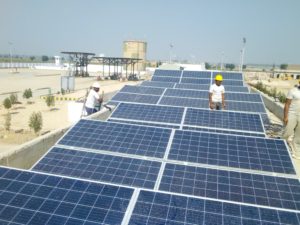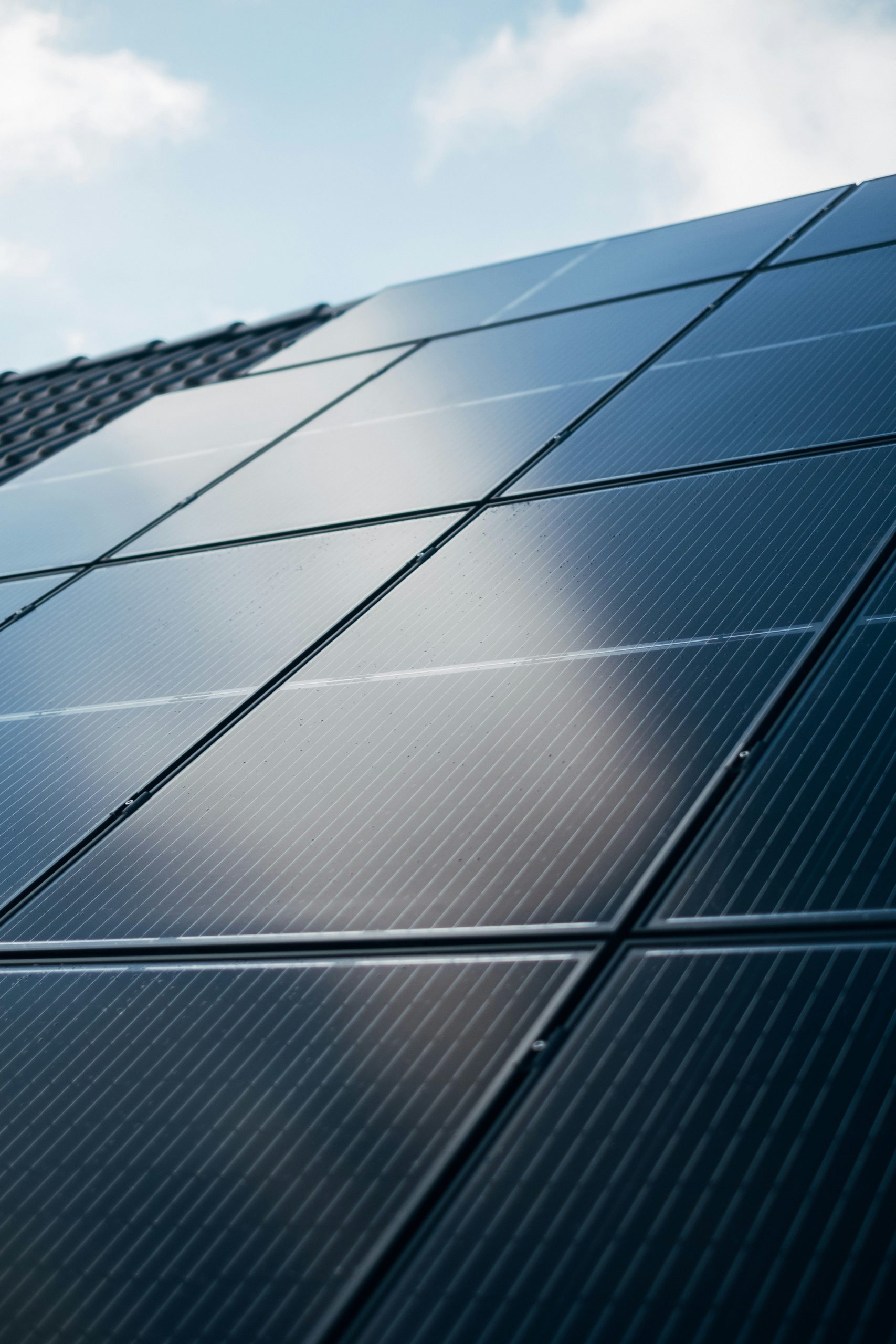Why is it important?
Energy is at the heart of the climate challenge – and the primary solution. Fossil fuels, such as coal, oil, and gas, are by far the main contributors to climate change, accounting for over 75% of global greenhouse gas emissions. Moreover, these resources are finite and are produced by a handful of countries which hold the key to global energy supply and stability.
What's the solution?
Halving emissions by 2030 requires alternative energy sources to fossil fuels. (1) Solar energy is a low-carbon renewable energy source with an efficiency of up to 24%. (2) Its use emits 44 g of CO2e per kWh, compared to 1058 for coal and 730 for fuel oil, for example. (3) Solar energy is available everywhere and can be used in many contexts and infrastructures, such as homes, schools, hospitals, and even on the ground. To install a solar energy system, a needs assessment is needed, with expert consultation to determine the size of the installation before setting it up. Equipment must be chosen for its robustness and installed by a reliable installer who will ensure the best possible performance, with a maintenance contract. Regular maintenance is crucial to ensure the lifespan and profitability of the panels. Finally, one must identify local recycling options for panels and batteries at the end of the life.
There are two types of solar energy systems : ‘small solar’ systems, or solar kits, which are transportable and easy to deploy, for example in emergency areas (4) providing small amounts of energy, and ‘large solar’ systems, which are fixed and produce larger amounts of energy and can be connected to the local electricity distribution network to both absorb fluctuations in production and compensate for an unreliable network. (5)
Point of attention
-
Point of attention
Solar energy is neither 100% carbon-free nor clean. The extraction of raw materials, production, transport, operation, and end-of-life of solar equipment all have a climate, energy, and water cost. The extraction of metals and rare earths, such as lithium for batteries, is polluting and raises questions about human rights. (6)
Furthermore, all these devices have a limited lifespan, and their end-of-life must be given special attention. While panels are becoming increasingly recyclable, recycling batteries can be complicated in certain contexts.
Greenhouse gas emissions per 1 of electricity produced

Greenhouse gas emissions per 1 of electricity produced (9)
Nuclear → 6 g CO2-eq / kWh
Hydroelectric energy → 12 g CO2-eq / kWh
Wind energy → 15 g CO2-eq / kWh
Solar photovoltaic energy → 44 g CO2-eq / kWh
Natural gas → 418g CO2-eq / kWh
Fuel oil → 730g CO2-eq / kWh
Coal → 1058g CO2-eq / kWh
Key actions
-
#1 Diagnose and assess needs
Conduct an energy audit to estimate consumption and propose a suitable solution. Consider other forms of renewable energy where relevant.
-
#2 Rely on experts
Mobilise professional expertise. Internalising expertise allows for monitoring progress, operator training, and proper functioning and maintenance of installations, but requires financial resources (design, training, operation, maintenance). Outsourcing expertise requires experienced service providers, long-term maintenance contracts, and sufficient funds over installations’ lifetime.
-
#3 Consider cost-effectiveness of the installations
Choose cost-effective installation according to panels’ efficiency (power, orientation, sunlight), initial investment, operating and maintenance costs, and type of installation (self-consumption or resale of surplus energy). Solar kits or ‘small solar’ systems designed for emergency situations have a shorter lifespan and their profitability is difficult to quantity.
-
#4 Choose the right equipment
Choosing robust equipment, that can be repairable locally or regionally, while remaining efficient (their efficiency can vary from 10 to 24% depending on their technology). (10) Applying environmental and sustainability criteria. Favour suppliers who are committed to transparency and traceability. (11)
-
#5 Position the installation correctly
Position solar installations in order to optimise electrical output, by taking into account the orientation in relation to the sun, as well as shadows (neighbouring buildings, foliage, etc.) and accessibility for regular maintenance.
-
#6 Monitor and clean regularly the installations
-
#7 Consider reselling surplus energy
Self-consumption allows energy produced to be reused directly by storing it in batteries for a few hours. Aid and healthcare organisations are advised to target a maximum of 80% of the building’s energy needs and to maintain another possible energy source.
-
#8 Train staff
Raising awareness among users about the rational use of electricity and train a team to carry out simple maintenance on the panels.
Image

To consider
-
Potential co-benefits
- Energy independence
- Lower energy bills and financial gains if energy is sold back to the grid
- Reduced fossil fuel consumption and therefore lower greenhouse gas emissions
-
Success conditions
- Suitable sunlight conditions
- Suitable temperatures
- Regular maintenance of the installations
- Carefully considered orientation and location of the installation
-
Prerequisites & specificities
- No existing network offering green energy
- Expertise availability
- Long-term contract with service provider
- Quality of solar panels
- Upstream cost and risk analysis
- Suitable structures for large-scale energy (solar panels)
-
Potential risks
- Short lifespans of installations due to lack of maintenance and repair
- Malfunctioning installations if quality is not satisfactory
- Electronic waste (batteries, pollution, non-recycled panels)
- Environmental and social risks if the supplier is unreliable
- Fire in the event of poorly installed solar panels (minimal risk)
Tools and good practices
-
Climate Action Accelerator Solarisation Toolkit, 2024
The Climate Action Accelerator Solarization toolkit provides a step-by-step guide to solarizing buildings with a particular focus on International humanitarian field projects and health structures in low- and middle-income countries.
Explore here -
Global Platform for Action on Sustainable Energy in displacement settings, 2024
The GPA promotes sustainable energy access in displacement situations, and proposes networking and online learning tools.
Explore here -
Photovoltaic energy sheet, ADEME, 2022 (in French)
Information sheet from the French Agency for Ecological Transition on solar energy, with examples and online training courses in French, mainly for the French context.
Explore here -
Recommendation guide for photovoltaic projects, ADEME, 2022 (in French)
Recommendations guide for photovoltaic project developers, ADEME
Explore here
To go further
-
Solar webinars, Climate Action Accelerator, 2023
Two webinars organised by the Climate Action Accelerator on solar photovoltaic energy: "How can solar energy be widely deployed and sustained in the international aid and health sectors?", and "What partnerships, services, and expertise need to be developed to deploy solar energy on a large scale?"
Explore here -
Environment Life Cycle Assessment of Electricity from PV Systems, IEA PVPS, 2022
Presentation of the life cycle analysis (LCA) of a photovoltaic system.
Explore here -
Solar Resource maps & GIS data
Solar radiation maps by country.
Explore here -
History of photovoltaics, TERRE SOLAIRE, 2023 (in French)
A brief history on solar energy.
Explore here -
Briefing on Healthcare Electrification in Humanitarian Settings
This report presents the challenges and solutions related to the electrification of healthcare facilities in humanitarian contexts, with a focus on access to sustainable energy and case studies on sub-Saharan Africa.
Explore here
Acknowledgments
This factsheet was prepared with the support of Électriciens sans frontières. Last updated on 12th of May 2025.
Share your best practices, suggestions, and comments with us! contact@climateactionaccelerator.org
Sources
(1) United Nations, ‘Renewable energy – powering a safer future’, United Nations, available here, (accessed 20 May 2025)
(2) ENGIE, ‘Quel est le rendement d’un panneau solaire ? vérité et calcul’, ENGIE, 2023, available here, (accessed on 20 May 2025) (in French)
(3) Y. Dkhissi, ‘Quelles sont les émissions de CO2 par source d’énergie ?’, Climate Consulting, 2024, available here, (accessed on 20 May 2025) (in French)
(4) Mon Panneau Solaire, ‘Le photovoltaïque en site isolé’, Mon Panneau Solaire, available here, (accessed on 20 May 2025) (in French)
(5) Agence Internationale de l’Energie, ‘Solar PV’, Agence Internationale de l’Énergie, 2025, available here, (accessed on 20 May 2025)
(6) Amnesty International, ‘Amnesty International lance un défi aux leaders de l’industrie: produire des batteries électriques’, Amnesty International, 2019, available here, (accessed on 20 May 2025)
(7) Actu Solaire, ‘Évolution mondiale de l’énergie solaire entre 2015 et 2021’, Actu Solaire, available here, (accessed on 20 May 2025) (in French)
(8) S. Preet and S. Smith, ‘A comprehensive review of the recycling technology of silicon based photovoltaic solar panels: Challenges and future outlook’, Journal of Cleaner Production, 2024, available here, (accessed on 20 May 2025)
(9) Trajectoires, ‘Les énergies décarbonées’, Trajectoires, available here, (accessed on 20th May 2025) (in French)
(10) ENGIE, ‘Calculez la rentabilité des panneaux solaires: notre guide 2025 ?’, ENGIE, 2024, available here, accessed on 20th May 2025) (in French)
(11) World Economic Forum, ‘Africa is leading the way in solar power potential’, World Economic Forum, 2022, available here, (accessed on 20th May 2025)
(12) Dani, ‘Tempête de pluie et boue : l’importance du nettoyage des panneaux solaires’, Greening solutions, available here, accessed on 20th May 2025) (in French)
(13) ENGIE, ‘Quel est la durée de vie d’un panneau solaire ?’, ENGIE, 2024, available here, accessed on 20th May 2025) (in French)
Featured
Renewable energy

Energy and buildings

Credits
Cover photo: Benjamin Jopen/Unsplash
